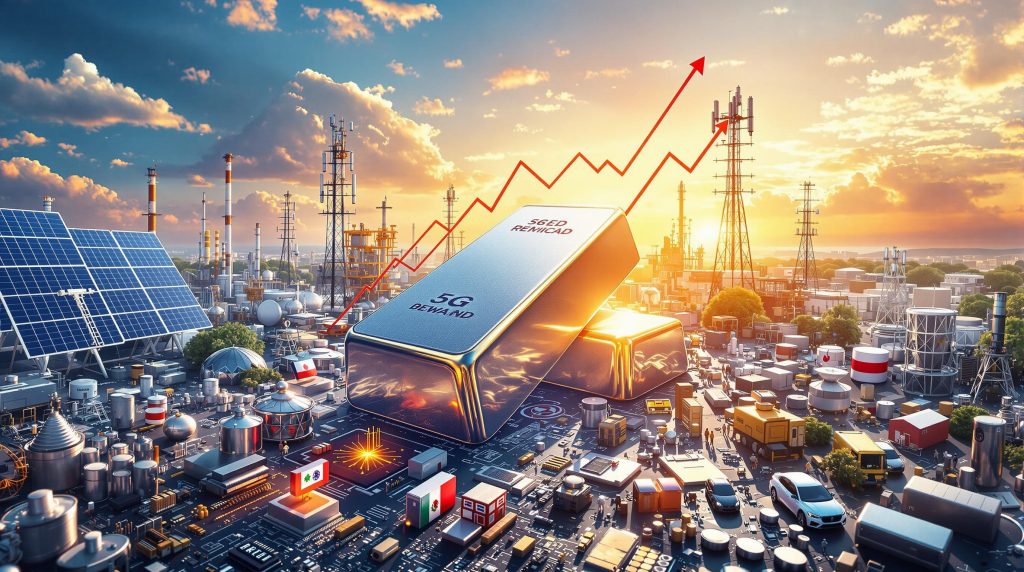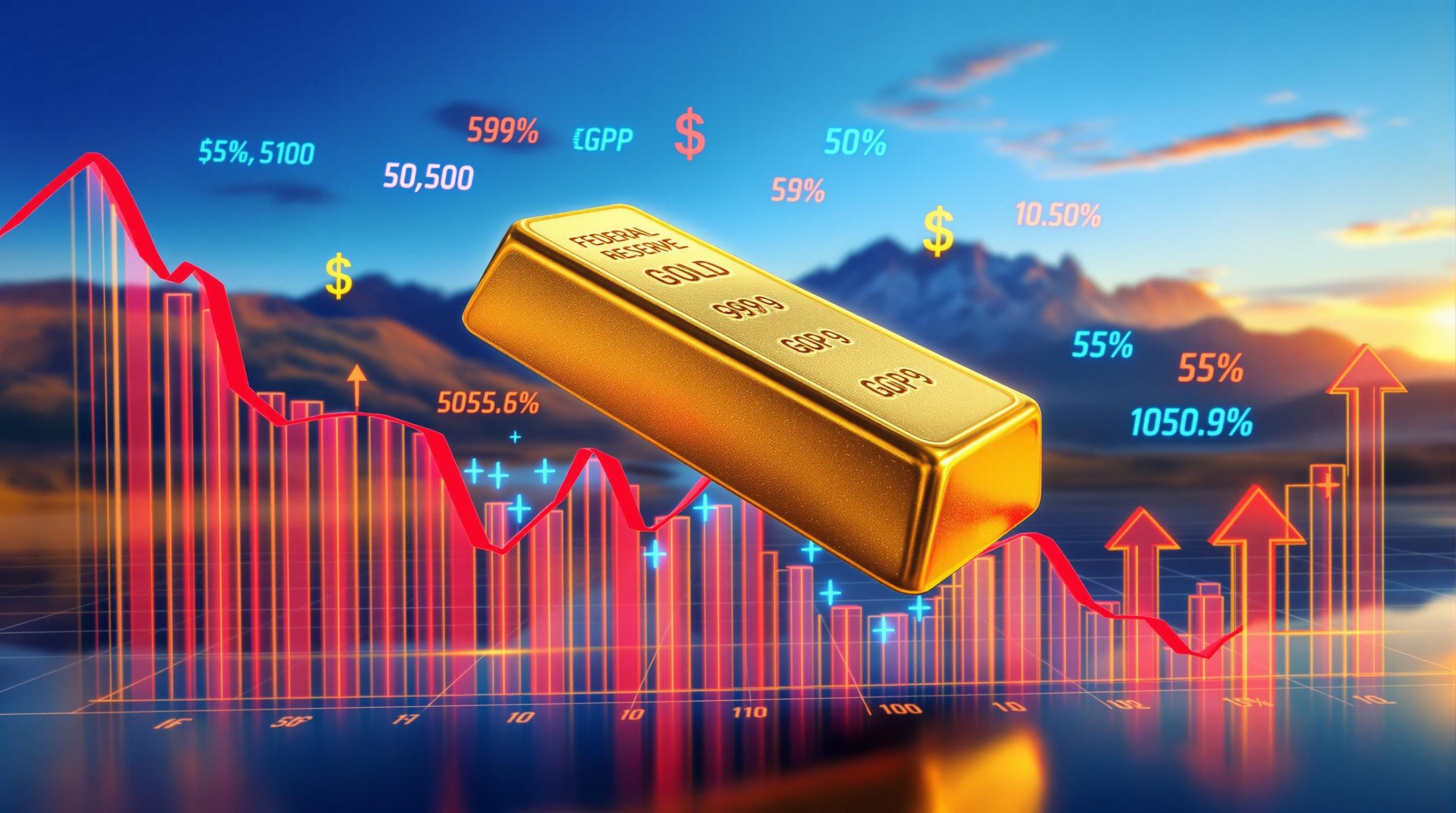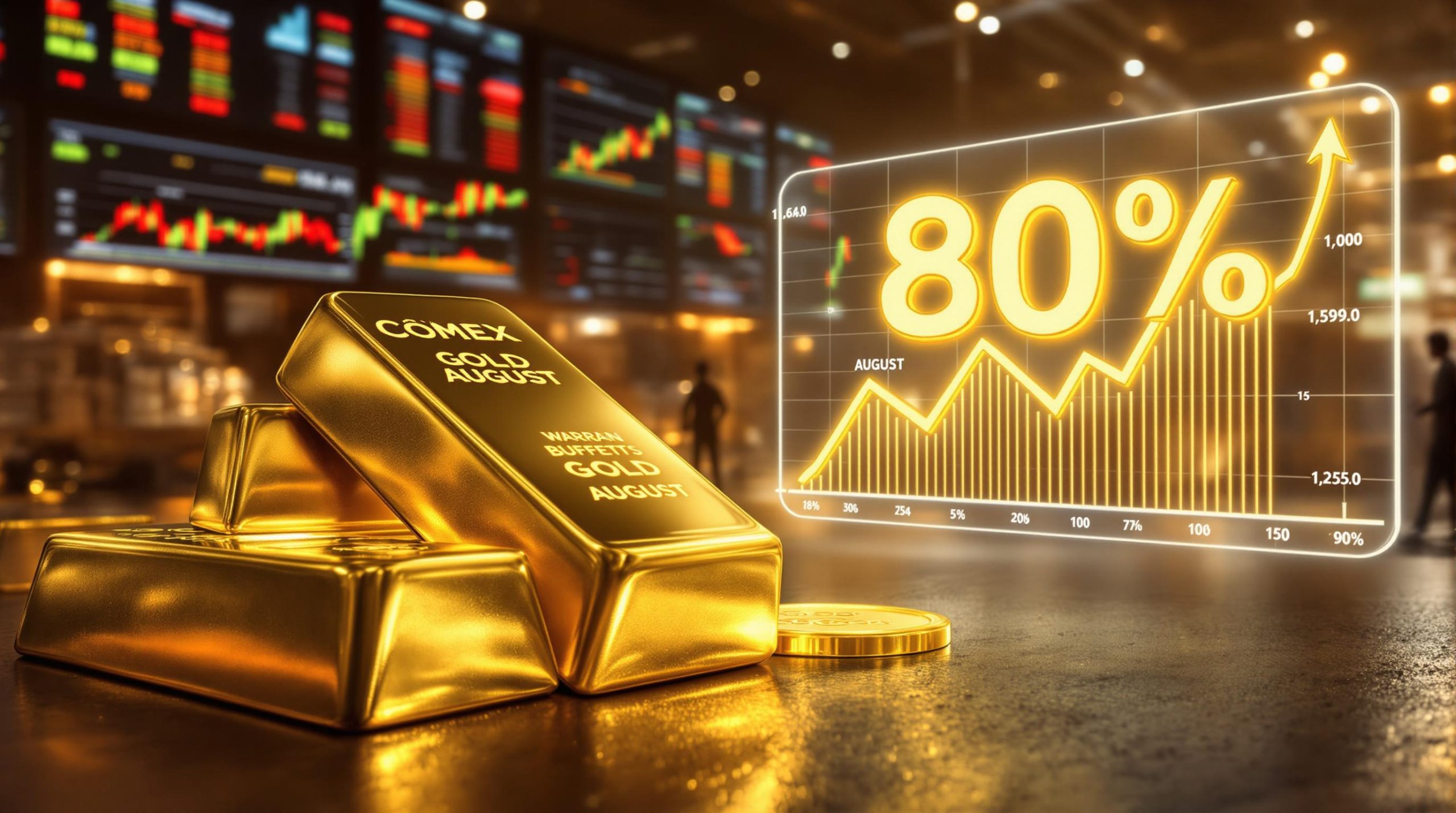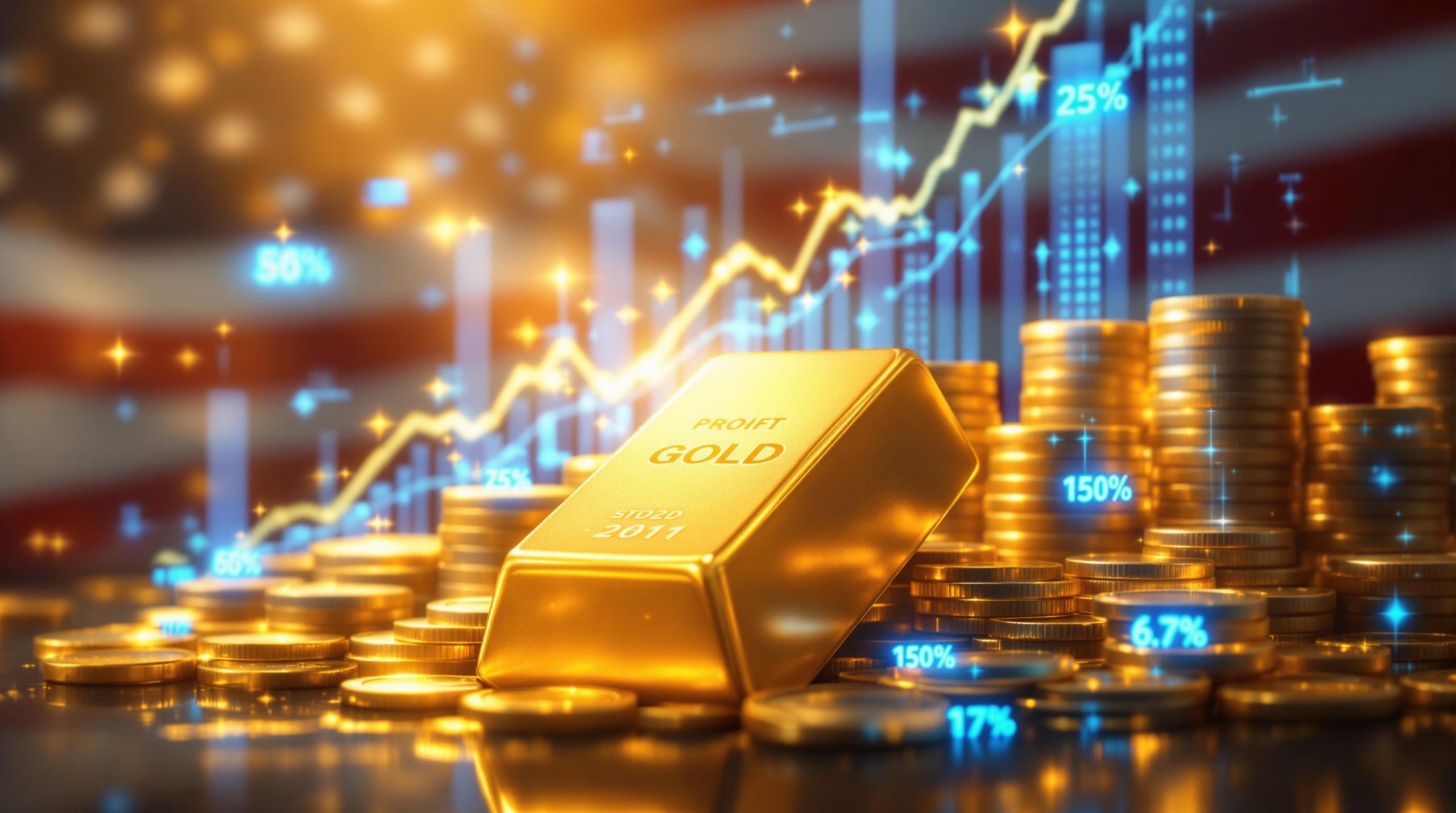Understanding Silver's Structural Deficit: How Industrial Demand is Reshaping the Market
What is Causing Silver's Current Structural Deficit?
Silver's market fundamentals have shifted dramatically in recent years, creating a persistent structural deficit that shows no signs of abating. The imbalance between supply and demand has become increasingly pronounced, with industrial applications driving unprecedented consumption levels while mining output struggles to keep pace.
The supply-demand gap isn't just a temporary market fluctuation—it represents a fundamental shift in silver's structural deficit and industrial demand that savvy investors are beginning to recognize and capitalize on.
The Growing Supply-Demand Imbalance
At its core, silver's structural deficit stems from a straightforward mathematical reality: industrial demand is growing at a robust 3.6% annually while supply contracts at 0.9% per year. This divergence creates a widening gap that market forces have yet to resolve through price mechanisms.
This imbalance hasn't developed overnight. Traditional mining operations face mounting challenges with declining grades, more complex geology, and significantly extended mining permitting timelines. What once took 3-5 years to bring online now requires 7-10 years in major jurisdictions, according to comprehensive studies from the Fraser Institute.
The slower development cycle means supply cannot respond quickly to price signals, creating a prolonged period where demand outstrips available supply.
Industrial Applications Driving Demand Growth
Silver's market is undergoing a transformation driven by its unique dual role as both an industrial commodity and monetary asset. While investors often focus on silver's precious metal status, its industrial applications now account for over 60% of total demand—a figure that continues to climb with each technological advancement.
Several key sectors show accelerated growth trajectories:
-
Solar energy: Photovoltaic installations now consume approximately 15% of annual silver supply, up from 10% five years ago according to International Energy Agency data. Each gigawatt of solar capacity requires between 20-25 tons of silver, with no viable substitutes offering similar efficiency and durability.
-
Electric vehicles: The EV revolution demands substantial silver inputs, with each vehicle requiring between 25-50 grams for electrical components including battery management systems, autonomous driving features, and power control modules. As global EV production accelerates, this demand segment will grow proportionally.
-
5G infrastructure: Advanced telecommunications equipment relies heavily on silver's superior conductivity properties. Each 5G base station contains approximately 4-8 times more silver than previous generation equipment, creating substantial incremental demand as global networks expand.
-
Electronics manufacturing: Consumer and industrial electronics continue to require silver's unique properties. Despite miniaturization efforts, the proliferation of devices has maintained steady demand growth in this segment.
What makes these applications particularly significant for market dynamics is their price-inelastic consumption patterns. Electronics manufacturers, solar panel producers, and automotive companies will continue purchasing silver regardless of moderate price increases because the metal's properties are irreplaceable in these technologies.
As Michael Konnert, CEO of Vizsla Silver, explains: "You can definitely see the expanded investor interest in the metal and it's because silver does sit at this crossroads of industrial growth and monetary anxiety, and we're seeing that play out with the gold price – silver starting to catch up with gold."
How is Silver Supply Responding to Growing Demand?
While demand shows robust growth across multiple sectors, the supply response has been muted at best. Global silver production faces significant structural challenges that limit potential output growth, creating a persistent supply shortfall that market participants increasingly recognize as a long-term reality rather than a temporary anomaly.
Mine Production Challenges
Global silver mine production has contracted at a 0.9% CAGR since 2020, a trend that reflects deep-seated challenges in the production pipeline. Several factors contribute to this decline:
-
Declining ore grades: Average silver grades have decreased by approximately 25% over the past decade as easily accessible, high-grade deposits become depleted. This forces miners to process more material for the same silver output, increasing costs and environmental footprints.
-
Permitting delays: New mine development timelines have extended dramatically, with the average project now requiring 7-10 years from discovery to production in primary jurisdictions. Even in mining-friendly regions like Mexico, the timeline averages 8.5 years according to industry experts.
-
Geopolitical disruptions: Political instability in key producing regions like Mexico and Peru creates production uncertainty. Regulatory changes, tax regime modifications, and community relations challenges can significantly impact existing operations and future developments.
-
Underinvestment: Capital allocation to new silver projects has been insufficient to offset depletion rates. The prolonged bear market in precious metals from 2011-2019 resulted in exploration budgets being slashed, creating a thin development pipeline that cannot quickly respond to current demand signals.
This table summarizes the current supply dynamics:
| Silver Supply Trends | Annual Change (%) | Key Factors |
|---|---|---|
| Mine Production | -0.9% | Grade decline, permitting delays |
| Recycling | +1.2% | Price-responsive but limited volume |
| Total Supply | -0.6% | Insufficient to meet demand growth |
The Critical Role of Existing Producers
In this supply-constrained environment, operational mines with expansion potential have gained strategic importance. Companies with established infrastructure, existing permits, and proven resources can respond more quickly to market signals compared to greenfield developments.
This advantage becomes particularly pronounced when considering the capital efficiency of expanding existing operations versus building new facilities. Brownfield expansions typically require 30-50% less capital per ounce of production capacity and can be brought online in 2-3 years rather than the 7-10 years needed for new developments.
As Michael Konnert of Vizsla Silver notes regarding development timelines: "It really has to do with the jurisdiction in Mexico – Mexico gets a lot of knocks right, but on average in Mexico the amount of time it takes to go from discovery to production is about 8 and a half years, so we're on track for that basically."
This reality creates a meaningful advantage for companies with existing operations and established relationships with regulatory authorities, local communities, and service providers. Their ability to expand production more quickly allows them to capitalize on rising prices while new entrants face lengthy development cycles.
What's Driving Institutional Investment in Silver?
While industrial demand creates the fundamental case for silver's structural deficit, institutional investment flows have begun to recognize and position for this reality. The investment thesis combines both fundamental industrial demand growth and silver's traditional role as a monetary metal and inflation hedge.
Exchange-Traded Product Flows
Institutional capital has flowed aggressively into silver-backed exchange-traded products (ETPs), with inflows exceeding 95 million ounces in the first half of 2025 alone. This already surpasses 2024's full-year total, signaling strong institutional positioning ahead of anticipated supply shortfalls.
Net inflows have increased 9% year-to-date, demonstrating accelerating momentum as more institutional investors recognize silver's unique position at the intersection of industrial demand and monetary protection. Total assets under management in silver-focused ETPs have reached approximately $40 billion by mid-2025, reflecting both price appreciation and continued capital inflows.
What's particularly notable about these flows is their persistence despite occasional price volatility. Unlike previous cycles where investment demand quickly evaporated during corrections, current institutional positioning appears more strategic and conviction-based rather than merely tactical.
Monetary and Currency Factors
Silver's historical correlation with real yields (approximately -0.75 over the past decade) demonstrates its sensitivity to monetary policy conditions. As real yields have compressed and in some cases turned negative, silver has become increasingly attractive as a non-yielding asset with industrial demand support.
The softer US dollar environment in 2025 has amplified investment demand in non-US jurisdictions, creating a supportive macroeconomic backdrop for silver price strategies. This relationship works through several mechanisms:
- Lower real yields reduce the opportunity cost of holding non-yielding assets like silver
- Dollar weakness makes silver more affordable in local currency terms for non-US buyers
- Inflation concerns drive diversification into hard assets with industrial demand support
- Currency debasement worries create demand for assets outside the traditional financial system
These monetary factors complement the industrial demand narrative rather than competing with it, creating a "double engine" of potential price support.
Portfolio Diversification Trends
Institutional investors are increasingly allocating to silver as part of broader real asset strategies amid:
- Persistent inflation concerns despite central bank tightening efforts
- Currency debasement worries as government debt levels remain elevated
- Compressed Treasury yields that limit income from traditional fixed income
- Desire for tangible asset exposure with industrial demand support
This capital allocation reflects strategic positioning rather than tactical trading, indicating long-term conviction in silver's fundamental outlook. Many institutional portfolios that previously held only gold exposure have expanded to include silver, recognizing its unique supply-demand dynamics and potential for outperformance in specific economic scenarios.
Unlike retail investment flows which tend to chase momentum, institutional positioning typically reflects deeper analysis of fundamental factors and longer investment horizons. The sustained nature of current institutional inflows suggests conviction in silver's silver market squeeze rather than speculative positioning.
How Do Production Economics Impact Silver Mining Companies?
The economics of silver production vary dramatically across companies and projects, creating significant operational leverage to silver prices for low-cost producers. Understanding these cost structures provides insight into which companies stand to benefit most from rising silver prices and the structural deficit.
Cost Structure Advantages
All-in sustaining costs (AISC) across the silver mining industry currently average $19.80 per ounce. However, companies with high-grade deposits or operational efficiencies can achieve substantially lower costs, creating significant margin advantages in today's price environment.
For example, Vizsla Silver's preliminary economic assessment indicates projected AISC of $9.40 per ounce at their Panuco project, less than half the industry average. This cost advantage creates substantial operational leverage to silver prices, with each $1 increase in silver price flowing directly to the bottom line with minimal additional costs.
Cost advantages typically stem from several factors:
- Ore grade: Higher-grade deposits require less material processing per ounce produced
- Mining method: Open-pit operations generally have lower costs than underground mines
- By-product credits: Many silver mines produce valuable base metals that offset costs
- Infrastructure access: Proximity to power, water, and transportation reduces expenses
- Regulatory environment: Jurisdictions with streamlined permitting and predictable taxes
Companies with multiple cost advantages can operate profitably even during price downturns while generating exceptional margins during bull markets.
Project Economics and Development Timelines
Silver mining projects with robust economics show several common characteristics that make them particularly attractive in the current market environment:
-
Internal rates of return: Leading projects exceed 80% at current silver prices, with Vizsla Silver reporting an impressive 86% IRR in their preliminary economic assessment, supported by a $1.1 billion post-tax NPV at a 5% discount rate.
-
Payback periods: Top-tier assets achieve payback in under 12 months, allowing companies to quickly recoup capital investments and reduce project risk.
-
Capital intensity: Lower capital requirements per ounce of production capacity improve financial flexibility and reduce financing challenges.
-
Development schedules: Mexico's average timeline from discovery to production is approximately 8.5 years, highlighting the importance of projects already in advanced development stages.
-
Discovery costs: Efficient exploration programs can dramatically improve overall project economics. Vizsla Silver reports discovery costs of just $0.41 per ounce silver equivalent, substantially below industry averages.
These metrics provide a framework for evaluating which projects are most likely to advance to production and generate meaningful returns for investors.
Operational Leverage to Silver Prices
Mining companies with low cost structures provide amplified exposure to rising silver prices. For every $1 increase in silver prices above the cost of production, margins expand proportionally, creating significant cash flow growth potential.
This operational leverage makes select silver producers particularly attractive in environments where silver prices are expected to rise due to structural deficits. Companies operating at $10/oz costs experience twice the margin expansion from a $1 price increase compared to peers producing at $15/oz.
The compounding effect of rising production and expanding margins can create exponential growth in free cash flow, allowing companies to accelerate development timelines, increase exploration budgets, or return capital to shareholders through dividends or buybacks.
What Makes Certain Silver Projects Stand Out?
Not all silver projects are created equal. Several key characteristics distinguish exceptional silver assets from average deposits, creating substantial value differentiation that investors should understand when evaluating companies in the sector.
Resource Scale and Quality
Tier-one scale assets attract capital allocation even in tightening financing environments. Projects with substantial resource bases (>100 million ounces silver equivalent) provide development optionality and strategic flexibility that smaller deposits cannot match.
For example, Vizsla Silver's Panuco project hosts a 240 million ounce silver equivalent resource, providing sufficient scale to support multiple potential development scenarios and long mine life. Similarly, Cerro de Pasco Resources controls a massive 423 million ounce silver equivalent tailings resource, demonstrating the scale necessary to attract institutional investment.
Scale matters for several reasons:
- Production profile: Larger resources support higher annual production rates
- Mine life: Extended operational lifespans reduce reinvestment risk
- Development options: Phased approaches can optimize capital efficiency
- Exploration potential: Larger systems often have additional growth opportunities
- Strategic value: Major producers seek resources of sufficient scale for acquisition
Beyond just size, resource quality factors like grade consistency, metallurgical recovery rates, and geotechnical stability significantly impact project economics and development risk.
Jurisdictional Advantages
North American and select Latin American jurisdictions offer regulatory stability compared to higher-risk regions, providing operational certainty that institutional investors increasingly demand. Permitting predictability and rule of law create significant competitive advantages for projects in these locations.
Mexico, despite occasional political challenges, maintains a strong mining culture and well-established regulatory framework that supports responsible resource development. As noted by industry experts, Mexico's average timeline from discovery to production of 8.5 years, while lengthy, remains predictable for companies that understand the local context.
Other jurisdictional factors that impact project value include:
- Tax regime: Royalty rates and profit-based taxes vary substantially by country
- Infrastructure: Access to power, water, and transportation networks
- Labor availability: Skilled workforce presence reduces training costs and turnover
- Security considerations: Physical security impacts operational continuity
- Community relations: Social license to operate affects development timelines
Companies operating in jurisdictions with favorable combinations of these factors can develop projects more quickly and with greater certainty than peers in challenging regions.
Environmental and Social Considerations
Modern silver mining increasingly incorporates environmental and social governance (ESG) principles that enhance project sustainability and community acceptance. Innovative approaches include:
- Tailings reprocessing initiatives that remediate historical environmental impacts while recovering valuable metals
- Water conservation technologies that reduce consumption and environmental footprint
- Community development programs that create shared value with local stakeholders
Cerro de Pasco Resources exemplifies this approach with their tailings reprocessing project in Peru. As CEO Guy Goulet explains: "We're creating wealth back in the community of Cerro de Pasco but we're eliminating all the trucking, the dynamite, the dust, and the noise. There's only one way to remediate the environment in Cerro de Pasco – you have to reprocess the tailings and remove the stockpile from where it is."
Beyond environmental remediation, the project also contains significant concentrations of critical minerals like gallium. Goulet notes: "We've got a lot of gallium. We're moving up the average now at 30 grams per ton gallium. After 40 holes, we are now at 53 grams per ton gallium, and the last two holes to the south average 86 grams per ton gallium."
This innovative approach demonstrates how modern silver projects can combine resource recovery with environmental remediation, creating multiple value streams while addressing historical mining impacts.
How Can Investors Gain Exposure to Silver's Structural Deficit?
Investors seeking exposure to silver's structural deficit have multiple options, each with different risk-reward profiles and leverage to silver prices. Understanding these various approaches helps investors construct portfolios aligned with their specific investment objectives and risk tolerance.
Direct Physical Ownership
Physical silver ownership through coins, bars, or allocated storage provides pure exposure to silver prices without operational risks. However, this approach lacks the operational leverage that mining equities can offer.
Advantages of physical ownership include:
- No counterparty risk: Direct ownership eliminates company-specific operational risks
- Permanent capital preservation: Physical silver doesn't depreciate or expire
- Privacy benefits: Some physical ownership structures offer confidentiality
- Potential premium appreciation: Certain coins and bars command collectible premiums
The primary disadvantages include storage/insurance costs and lack of yield while holding the metal. Physical ownership works best for investors seeking pure price exposure with minimal operational risk.
Silver Mining Equities
Companies focused on silver production provide amplified exposure to rising prices through operational leverage. Key factors to consider when evaluating silver miners include:
-
Production profile: Current and projected silver output. Companies with growing production profiles benefit from both higher prices and increased volume.
-
Cost structure: All-in sustaining costs relative to industry averages. Low-cost producers like Vizsla Silver (projected $9.40/oz AISC) provide maximum leverage to rising prices.
-
Balance sheet strength: Cash position and debt levels impact financial flexibility. Vizsla Silver's $200 million cash position with no debt represents an exceptionally strong financial foundation.
-
Development pipeline: Near-term production growth opportunities extend the runway for equity appreciation as new projects come online.
-
Exploration potential: Resource expansion possibilities
Ready to Stay Ahead of Major Mining Discoveries?
Don't miss out on identifying the next big mineral discovery opportunity that could deliver substantial returns. Gain immediate insights with Discovery Alert's proprietary Discovery IQ model by visiting our discoveries page and start your 30-day free trial today.




